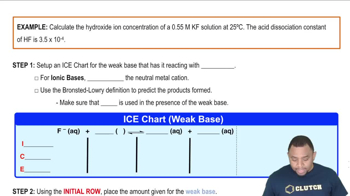Here are the essential concepts you must grasp in order to answer the question correctly.
Base Dissociation Constant (Kb)
The base dissociation constant (Kb) quantifies the strength of a base in solution. It is defined as the equilibrium constant for the reaction in which a base accepts a proton from water, forming its conjugate acid and hydroxide ions. A higher Kb value indicates a stronger base, while a lower value suggests a weaker base. In this case, ammonia has a Kb of 1.8 x 10^-5, indicating it is a weak base.
Recommended video:
Characteristics of Ka and Kb
pH and pOH Relationship
pH is a measure of the acidity or basicity of a solution, defined as the negative logarithm of the hydrogen ion concentration. The pOH is similarly defined for hydroxide ions. The relationship between pH and pOH is given by the equation pH + pOH = 14 at 25°C. For a solution with a pH of 11.68, the pOH can be calculated, which is essential for determining the concentration of hydroxide ions in the solution.
Recommended video:
Concentration of Hydroxide Ions [OH-]
The concentration of hydroxide ions ([OH-]) in a solution can be derived from the pOH value. Once the pOH is calculated from the pH, the concentration of hydroxide ions can be found using the formula [OH-] = 10^(-pOH). This concentration is crucial for applying the Kb expression to find the concentration of ammonia in the solution, as it relates to the equilibrium established when ammonia dissociates in water.
Recommended video:
Hydroxide Ion Concentration Example



